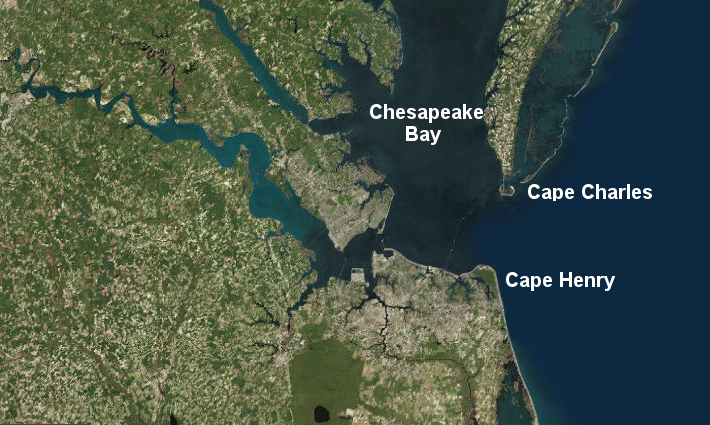
the English who arrived in April, 1607 named Cape Charles and Cape Henry after the two sons of King James I
Source: ESRI, ArcGIS Online

the English who arrived in April, 1607 named Cape Charles and Cape Henry after the two sons of King James I
Source: ESRI, ArcGIS Online
The English landed at Cape Henry on April 26, 1607. At the end of that first day, five Indians attacked the 30 Englishmen onshore and injured two of them.
The first meeting between the two cultures was hostile; the first engagement between English colonists and Native Americans was not a "welcome strangers; let's trade" moment. According to George Percy:1

the scene of the first English-Native American conflict in Virginia is now a military installation, Fort Story - and Seashore State Park has been renamed First Landing State Park
Source: ESRI, ArcGIS Online
The attack at Cape Henry must have been made on the initiative of the local Native Americans living in what today is called First Landing State Park. The territory, now in the City of Virginia Beach, was controlled by the paramount chief Powhatan but the attack occurred before he could be notified and issue any commands.
The rest of the Native Americans under the leadership of Powhatan allowed the English to explore the James River and settle on Jamestown Island. Powhatan did not attempt to kill or capture all the Europeans upon their arrival in his land of Tsenacommacah, or what the English called "Virginia." Powhatan probably did order the mild resistance to the English during later explorations between April 26-May 13, when the English started to unload the ships at Jamestown Island. He tested the capabilities of the strangers, without risking his warriors or making a clear enemy.
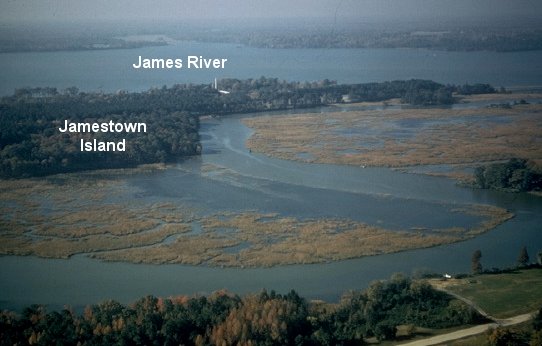
Jamestown Island
Source: National Park Service
Powhatan knew from the recent visits of ships in the Chesapeake Bay that the Europeans were a potential source of valuable tools (hatchets, knives) and prestige goods (shiny copper, blue beads). He would have known the stories, passed down through the generations, of the 1570-71 Spanish settlement at Ajacan, and the 1584-1587 English settlements on the Outer Banks.
At a minimum, Powhatan expected to exploit the English as a source of supply for scarce and valuable goods. English food and culture was not of much interest to the Native Americans, but metal tools, decorative objects for trade, and guns were valued.
From Powhatan's point of view, the English had the potential of becoming even more than trade partners. They might become military allies, fighting together with Powhatan's tribes and using their weapons to overcome the Manahoacs and Monacans from west of the Fall Line, and to block incursions from Susquehannocks from the northern edge of the Chesapeake Bay or the Massawomecks from further north.
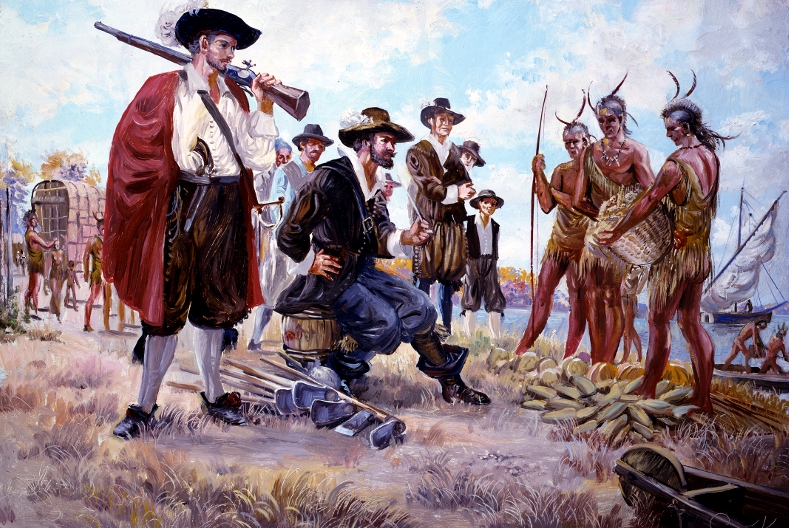
Powhatan could increase his power and expand his control over neighboring tribes, as long as he had exclusive access to the English goods. Powhatan tried to keep the English from trading directly with other tribes, but the English had a technology that defeated him. The sailing ships allowed the English to sail beyond the boundaries of Tsenacommacah, and trade with the non-subordinate tribes such as the Patawomeck. In 1613, the Patawomeck traded Pocahontas for a copper kettle during such a trading expedition.
Powhatan had a choice other than trading with the English. He could kill them all, before they got settled.
The Native Americans had bows and arrows that were lethal at 50 yards, and could fire arrows far faster than the English could reload matchlock guns. On land, the Native Americans had a military advantage.
On the water, the English were dominant. They could erect protective wooden barriers while on the deck of their ships, the Susan Constant, Godspeed, and Discovery. The Native Americans could shoot large numbers of arrows at the ships from shore and from canoes, but the English had too much protection. The cannon of the English were both frightening and lethal, capable of quickly killing large numbers of warriors in canoes or massed on the shoreline.
Powhatan must have considered trying to seize the three sailing ships, but never made a mass attack on them. In 1608, John Smith's shallop (a smaller vessel than the three ships that sailed across the Atlantic Ocean) was attacked by different tribes while leading trading/raiding expeditions. The Native Americans were easily repulsed by the shallop. English ships were movable wooden forts, and offered effective defenses against the spears and arrows of the Native Americans.
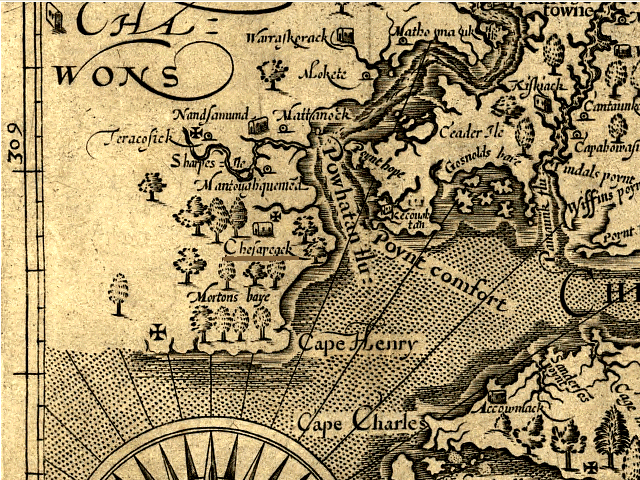
John Smith's map shows the town of the Chesapeake tribe to be closest to Cape Henry, site of the first interaction between the 1607 colonists and the Native Americans
(note that on Smith's map, north is to the right rather than to the top)
Source: Library of Congress, Virginia (John Smith, 1624)
Powhatan allowed the English to settle in initially at Jamestown, but he constantly sent spies to the English camp to assess both their resources and their defense capabilities. One day in late May, 1607, he saw an opportunity.
Over 20 of the English were exploring upriver. amestown had no defensive fortifications except one half-moon of brush, and most of the English guns were still unpacked. Powhatan chose to order a frontal assault on the English camp.
In the attack, one boy was killed and 17 men hurt. The death toll could have been much worse, but one of the ships in the James River fired a cannon and the projectile struck the branches of a tree above the camp.
That noise of the unfamiliar weapon and the effect on cannon projectiles hitting the trees frightened the attackers. They fled, and the English learned their lesson. The colonists started construction of the 3-sided palisade known as James Fort.2
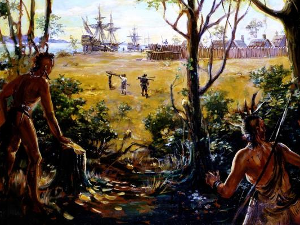
the English built a protective palisade - hard work, but easier with iron axes than stone tools - only after being attacked
Source: National Park Service, Watching the Colonists Construct James Fort
In his personal history of the first two years of colonization, John Smith described the initial experience with Native Americans ("salvages") at Fort Henry. Until the colonists arrived at Virginia, Captain Christopher Newport was the expedition leader. Upon arrival, the colonists were directed to open a sealed box with the Virginia Company's designation of the council that would lead the colony.
Though the company directed that John Smith would be on the council as a leader of the colony, the others had grown so tired of his behavior during the ocean crossing that they refused to seat him on the council. According to the version of history written by Smith, the President of the Council (Edward Maria Wingfield) refused to build a protective fortification and kept most weapons hidden in storage barrels ("dry fats") until after Powhatan ordered an attack on the English camp:3
After the attack on the colony, but before the fort was completed, Powhatan adjusted his military and political objectives for dealing with the colony. George Percy notes Powhatan used food as a tool in his negotiations:4
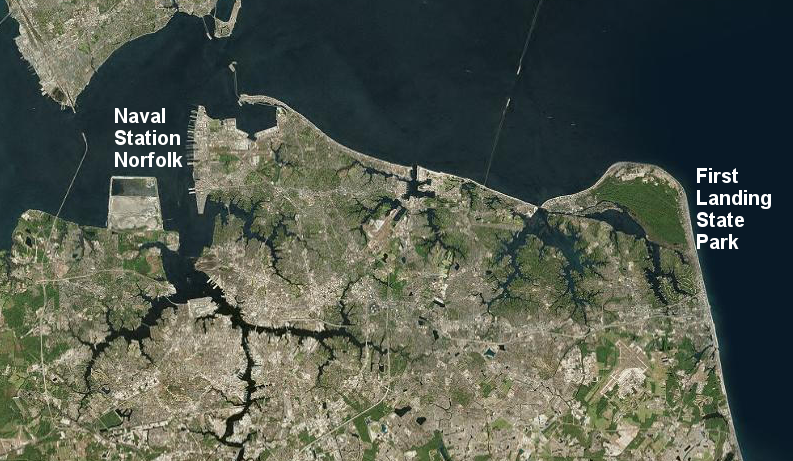
the largest naval base in the world is now just 20 miles west of the scene of the first English-Native American conflict in Virginia
Source: ESRI, ArcGIS Online
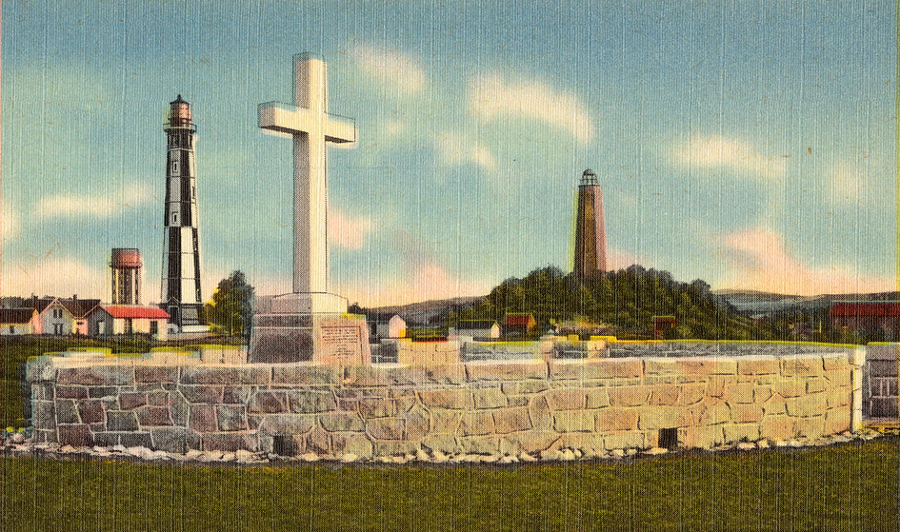
the Cape Henry Memorial was highlighted in a pre-World War II postcard
Source: Boston Public Library, Cape Henry Memorial and old and new lighthouses, Cape Henry, VA